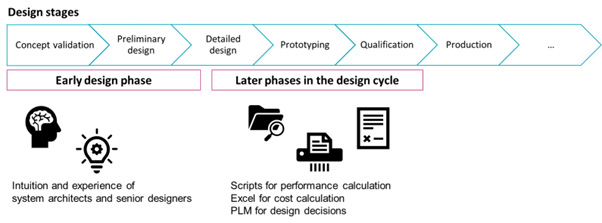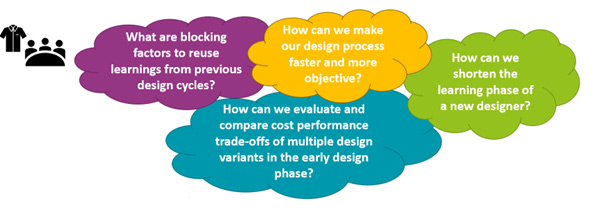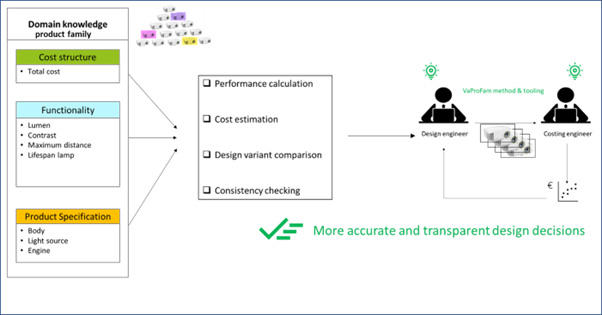From product knowledge towards design optimisation

From product knowledge towards design optimisation
Designing a new, viable and valuable product is often a long process in which experts from many disciplines are involved. Think for instance of experts working on improving product performances, experts focussing on costing and operational experts that evaluate the manufacturability of the design candidate.

However, and this is probably a less known fact about product design, the first design decisions that are taken to meet new user requirements often already absorb up to 80% of the final product cost.

Decisions in this early design phase are often based on the intuition and experience of senior system architects and senior designers. This makes them subjective and dependent on the presence (and state-of-mind) of these experts. To assure objective decisions while also making knowledge accessible to less experienced architects and designers, manufacturing companies are struggling with the following questions:
- What are the inhibiting factors to reuse learnings from previous design cycles?
- How can we make our design process faster and more objective?
- How can we shorten the learning phase of a new designer?
- How can we evaluate and compare cost-performance trade-offs of multiple design variants in the early design phase?

How to improve your design process? Structure and embed your product family knowledge
1. Identifying structure
A first crucial step to improve your early design process, is identifying a structure that allows you to document your product family knowledge. This structure is the backbone of your product family knowledge base. At least the following aspects are important to consider in your structure:
- product architectures and constraints on these architectures,
- product performance,
- cost types,
- ways to determine the costs related to
- the development, production and realisation of the product,
- design decisions,
- user requirements,
- mapping of links[MM1] between design decisions and design phases,
- mapping of links between architectures, design decisions, performance and cost.
2. Deciding on a way of working
A second step is deciding on a way of working for:
- using the product family knowledge base in your design process, and for
- keeping your knowledge base up to date.
It is clear that if the knowledge base is your source of truth, there can only be one current version in use. This version must be up to date to assure that the right decisions are made in the early design phase. The best way to include the knowledge base in your design process is to formally link the knowledge base to the actual designs and design candidates. This will allow you to create design templates, guide you through the design choices and feasible options and evaluate actual design decisions with respect to cost and performance. This formal link will also help your data scientists to use the domain knowledge in their analyses.

3. Consult your experts
A third important step is to consult your experts and collect all available product family knowledge in your company. Besides, not only knowledge within one discipline but also multi-disciplinary expertise must be made explicit and transparent. Doing this exercise will, for sure, bring new insights and expose gaps.
These three steps can be summarised as structuring your product family design knowledge and embedding this knowledge in the design process. When embedding the product family knowledge base in your company, it is good to be aware of the following relations to on-the-shelf software. While a product family knowledge base links your knowledge to cost and performance, design space exploration tools link your design data to cost and performance data. Furthermore, a product family knowledge base can be seen as an extension of the well-known Product Lifecycle Management (PLM) software to the early design phase. PLM software has a proven track record in capturing detailed design and production knowledge and data.
Flanders Make proof-of-concept for product family knowledge bases
With the input of at least six industrial manufacturing companies, Flanders Make has set-up a generic and broadly applicable structure for product family knowledge bases. This proof-of-concept has triggered a mind shift in companies, which are now well aware that making the effort to collect and review all expert knowledge on early design choices will indeed pay off: the knowledge base will not only speed up the development process, it will also help them to create more performant and/or cheaper designs that meet given user requirements. Another added value of the Flanders Make framework is that it allows to evaluate system level implications, originating from behaviour at component level. One opportunity that up to now is still unexploited but is within reach thanks to the backbone structure, is using the tool for automatically generating promising design candidates and for product family optimisation.
"By participating in this project, we were able to capture the widespread expertise of our people on an important (and recurring) topic, namely winding and unwinding. In an initial phase, we pooled this knowledge and checked it for correctness. People also had views that turned out to be incorrect. We then moulded this into a logic together with Flanders Make. For Bekaert Engineering, this was a unique process that we were able to carry out thanks to Flanders Make."
Hendrik van Hoecke,
Bekaert Engineering
